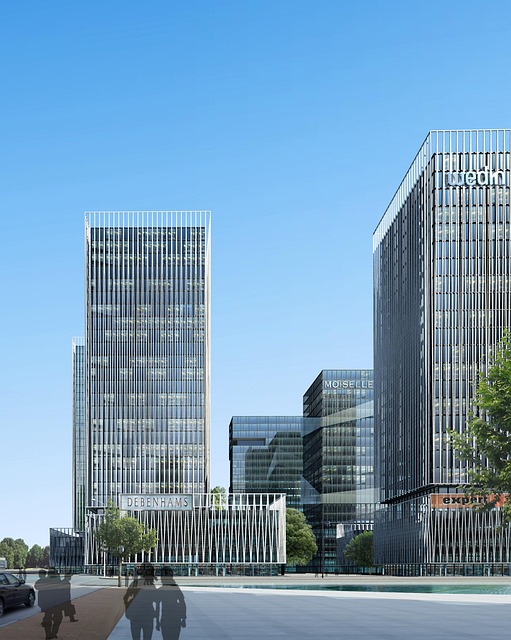Augmented Reality (AR) and Virtual Reality (VR) have dramatically improved exterior architectural rendering, enabling architects to create immersive digital experiences that bridge the physical and digital worlds. AR overlays digital information onto real spaces, allowing clients to interact with proposed designs, while VR creates fully digital 3D environments for virtual walks-through. Combining these technologies with high-quality 3D models offers deeper insights into design and layout, enhancing visual understanding. By facilitating interactive exploration, immediate feedback, and adjustments, AR/VR makes architectural design more engaging, efficient, and accessible, ultimately leading to successful projects and satisfied clients.
“Discover the future of architectural visualization with the integration of Augmented Reality (AR) and Virtual Reality (VR). This innovative approach transforms how designers and clients experience exterior architectural renderings, offering immersive interactions. The article explores the technologies behind AR and VR for external renderings, delving into their numerous advantages, from enhancing design communication to elevating client presentations. We’ll also navigate challenges, present real-world case studies, and provide insights on successful AR/VR integration in architectural projects, all focused on revolutionizing exterior architectural rendering.”
Understanding AR and VR Technologies for Exterior Architectural Rendering
Augmented reality (AR) and virtual reality (VR) technologies have transformed how we interact with digital content, opening up new possibilities for exterior architectural rendering. AR overlays digital information onto the real world, allowing users to see virtual elements seamlessly integrated into their physical surroundings. This technology is particularly useful in architectural visualization, enabling clients to experience proposed designs as if they were already built. By combining AR with high-quality 3D models and accurate scaling, architects can offer immersive, interactive views of exterior spaces, helping clients make informed decisions about design and layout.
On the other hand, VR creates entirely digital environments, providing a fully immersive experience. With VR headsets, architectural rendering can become a three-dimensional, virtual walk-through, giving users a chance to navigate through proposed buildings and gain a deeper understanding of space. This technology is invaluable for interior design, allowing architects to showcase intricate details, lighting schemes, and material choices in a way that traditional 2D renderings cannot match. Integrating AR and VR into exterior architectural rendering offers a powerful combination, bridging the gap between digital conception and physical reality.
Benefits of Integrating AR and VR in Architectural Design and Client Presentation
Integrating Augmented Reality (AR) and Virtual Reality (VR) technologies into architectural design offers a powerful set of tools for architects and designers to enhance their creative processes and client presentations. One of the key benefits is the ability to provide an immersive, interactive experience for clients, allowing them to virtually explore and engage with proposed designs in real-time. With AR, exterior architectural renderings can be overlaid onto real-world environments, giving clients a vivid understanding of how the final project will look and feel. This technology enables them to make more informed decisions, as they can walk through the space, observe different design elements, and even change certain aspects on the spot.
Furthermore, VR offers a fully immersive 3D experience, taking client presentations to the next level. Architects can create virtual walkthroughs of proposed buildings, providing clients with a chance to explore every detail from the comfort of their homes or offices. This technology facilitates better communication between designers and clients, as it allows for immediate feedback and adjustments. By combining AR and VR, architectural design becomes more accessible, engaging, and efficient, ultimately leading to happier clients and successful project outcomes.
Challenges and Considerations in Implementing AR/VR for Exterior Renderings
Implementing Augmented Reality (AR) and Virtual Reality (VR) for interactive viewing of exterior architectural renderings presents several challenges. One key challenge lies in achieving seamless integration between digital content and real-world environments, requiring precise mapping and alignment to ensure virtual elements appear naturally within physical spaces. This often involves complex processes such as photogrammetry, where 3D models are created from a series of 2D images, to capture intricate architectural details accurately.
Another consideration is the performance requirements for AR/VR systems. Real-time rendering of high-fidelity exterior architectural scenes demands powerful hardware and efficient algorithms to maintain smooth, responsive interactions. Latency issues can significantly impact user experiences, so optimizing both software and hardware configurations is crucial. Additionally, accessibility and inclusivity should be addressed, ensuring that AR/VR technologies are usable by a diverse range of individuals with varying physical abilities and technical proficiency levels.
Case Studies: Successful AR/VR Integration in Architectural Projects
The integration of Augmented Reality (AR) and Virtual Reality (VR) technologies has revolutionized the way architectural projects are visualized and experienced, offering a new dimension to exterior architectural rendering. Case studies have shown that AR/VR integration provides an immersive and interactive platform for clients, allowing them to virtually walk through and explore designs before construction begins. This technology enables architects to present complex building concepts in a more accessible manner, facilitating better client communication and decision-making.
One notable example is the use of AR in a high-rise residential project where potential homeowners could point their smartphones at a digital model of the building, accessing detailed interior renderings and even virtual tours. This interactive viewing experience not only enhanced client engagement but also helped identify design flaws or preferences early in the development stage. VR has similarly been utilized to create photorealistic simulations of complete structures, providing stakeholders with a realistic sense of scale and space, thereby streamlining the approval process.
The integration of augmented reality (AR) and virtual reality (VR) technologies revolutionizes the way we visualize and present exterior architectural renderings. By immersing clients in interactive 3D experiences, architects can enhance communication, foster collaboration, and ultimately improve project outcomes. While challenges exist, such as cost, technical complexity, and user training, successful case studies demonstrate that AR/VR integration is a game-changer for architectural design and client presentation. As we navigate this exciting landscape, embracing these immersive technologies will undoubtedly enrich the exterior architectural rendering process and elevate the overall design experience.
